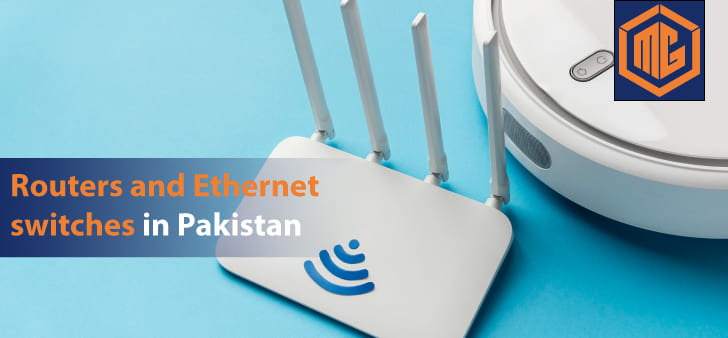Router and Ethernet switches in Pakistan

What are Routers?
A hardware device known to receive, analyze, and transmit incoming data is known as a router. The network is generally supported and set up to provide and establish a connection to a home or an office. A hub carries the transmission of data between different computers, mobile devices, and other wireless devices. It is also called a switch; a router can analyze the data it receives and transfers it to another network. They are quite as many different examples for types of routers such as –
Wireless router - Remote switches give Wi-Fi admittance to cell phones, PCs, and different gadgets with Wi-Fi network capacities. Additionally, they may provide standard Ethernet directing to a few wired organization gadgets. Some Wi-Fi switches can go about as a blend switch and modem, changing over an approaching broadband sign from your ISP.
Broadband Routers
These machines are connected to the Internet by telephone and use VoIP technologies to provide high-speed Internet connectivity. They are arranged and provided by the Internet Service Provider (ISP)
Edge routers
They are low-limit switches put at the fringe of the organizations. The interface between the internal organization to the outer organizations is appropriate for moving information parcels across networks. They use Border Gateway Protocol (BGP) for the network. There are two sorts of edge switches, endorser edge switches and mark edge switches.
Brouters
Brouters are specific switches that can give the functionalities of scaffolds too. Like a scaffold, brouters help to move information between networks. Furthermore, similar to a switch, the course the information inside the gadgets of an organization.
Core router
They can course information bundles inside a given organization yet can't course the organizations' parcels. They assist with connecting all gadgets inside an organization, subsequently framing the foundation of the organization. It is utilized by ISP and correspondence interfaces.
Routing table
The working of a switch generally relies on the steering table put away in it. The steering table stores the accessible courses for all objections. The switch counsels the directing table to decide the ideal course through which the information parcels can be sent.
Static routing table
The courses are taken care of physically and are not revived consequently. It is reasonable for little organizations containing 2-3 switches.
Dynamic routing table
The switch speaks with different switches utilizing directing conventions to decide the accessible courses. It is appropriate for more influential organizations to have an enormous number of switches.
Ethernet Switches
In the home or office, the Ethernet switch capacities as a focal station associating PCs, printers, and other wired gadgets. The switch is likewise wired to the switch and modem to get to the Internet, and the remote partner to Ethernet is Wi-Fi.
A network switch may refer to one of the three primary roles of remote control. Even though independent Ethernet switches have up to 48 ports, the Ethernet switch in the remote switch regularly has just four ports.
Switches can be wired to one another, every one separating to different gadgets. Extra switches become programmed Ethernet promoters. Each sent yield gets power from the AC source to the switch is connected.
Gigabit switches uphold 10, 100, and 1,000 Mbps (1 Gbps). The Gigabit standard added full-duplex transmission, which gives concurrent send and gets in each line. All Ethernet under 10,000 Mbps (10 Gbps) is in reverse viable and distinguishes the most remarkable regular speed between the association's two finishes. See 10 Gigabit Ethernet.
An essential "unmanaged" switch has no client arrangement, and there isn't anything to do aside from plug in the links and turn it on. Interestingly, for organization organizations, a "oversaw" switch can be designed to perform different errands, for example, change speeds, join clients in subgroups, screen traffic, and report movement. See virtual LAN, SNMP, crossing tree convention, and Ethernet.
An Ethernet switch controls the transmission of edges between switch ports associated with Ethernet links utilizing the traffic sending rules depicted in the IEEE 802.1D crossing over the norm. Traffic sending depends on on-location learning, and switches settle on traffic sending choices dependent on the 48-piece media access control (MAC) addresses utilized in LAN norms, including Ethernet.
To do this, the switch realizes which gadgets, called stations in the norm, are on which fragments of the organization by taking a gander at the source address in the entirety of the edges it gets. At the point when an Ethernet gadget sends a casing, it places two locations in the case. These two locations are the gadget's objective location, and it sends the casing to the source address; the gadget's location sends the edge.
Frame flooding
Switches consequently age out passages in their sending information base after a timeframe—regularly five minutes—if they don't perceive any casings from a station. Accordingly, if a station doesn't send traffic for an assigned period, at that point, the switch will erase the sending passage for that station. This shields the sending information base from developing loaded with lifeless sections that probably won't reflect reality.
When the location section has been planned out, the switch won't have any data in the station's information base whenever the switch gets an edge bound for it. This often arises whether a station is recently affiliated with a switch or was formerly associated with a switch but was recently refueled and abandoned five minutes later. So how does the switch handle bundle send for an obscure station?
The arrangement is necessary: the transfer advances the old casing to every station other than the one turned on, which floods the switch to any remaining stations.
Flooding the edge ensures that a casing with an obscure objective location will arrive at all organization associations and be heard by the right objective gadget, expecting it to be dynamic and on the organization. When the obscure gadget reacts with return traffic, the switch will naturally realize which port the gadget is on and presently don't flood traffic bound to that gadget.



